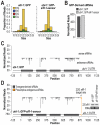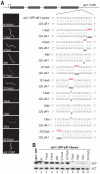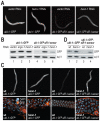PIWI associated siRNAs and piRNAs specifically require the Caenorhabditis elegans HEN1 ortholog henn-1
- PMID: 22536158
- PMCID: PMC3334881
- DOI: 10.1371/journal.pgen.1002616
PIWI associated siRNAs and piRNAs specifically require the Caenorhabditis elegans HEN1 ortholog henn-1
Abstract
Small RNAs--including piRNAs, miRNAs, and endogenous siRNAs--bind Argonaute proteins to form RNA silencing complexes that target coding genes, transposons, and aberrant RNAs. To assess the requirements for endogenous siRNA formation and activity in Caenorhabditis elegans, we developed a GFP-based sensor for the endogenous siRNA 22G siR-1, one of a set of abundant siRNAs processed from a precursor RNA mapping to the X chromosome, the X-cluster. Silencing of the sensor is also dependent on the partially complementary, unlinked 26G siR-O7 siRNA. We show that 26G siR-O7 acts in trans to initiate 22G siRNA formation from the X-cluster. The presence of several mispairs between 26G siR-O7 and the X-cluster mRNA, as well as mutagenesis of the siRNA sensor, indicates that siRNA target recognition is permissive to a degree of mispairing. From a candidate reverse genetic screen, we identified several factors required for 22G siR-1 activity, including the chromatin factors mes-4 and gfl-1, the Argonaute ergo-1, and the 3' methyltransferase henn-1. Quantitative RT-PCR of small RNAs in a henn-1 mutant and deep sequencing of methylated small RNAs indicate that siRNAs and piRNAs that associate with PIWI clade Argonautes are methylated by HENN-1, while siRNAs and miRNAs that associate with non-PIWI clade Argonautes are not. Thus, PIWI-class Argonaute proteins are specifically adapted to associate with methylated small RNAs in C. elegans.
Conflict of interest statement
The authors have declared that no competing interests exist.
Figures







Similar articles
-
The Caenorhabditis elegans HEN1 ortholog, HENN-1, methylates and stabilizes select subclasses of germline small RNAs.PLoS Genet. 2012;8(4):e1002617. doi: 10.1371/journal.pgen.1002617. Epub 2012 Apr 19. PLoS Genet. 2012. PMID: 22548001 Free PMC article.
-
Differential impact of the HEN1 homolog HENN-1 on 21U and 26G RNAs in the germline of Caenorhabditis elegans.PLoS Genet. 2012;8(7):e1002702. doi: 10.1371/journal.pgen.1002702. Epub 2012 Jul 19. PLoS Genet. 2012. PMID: 22829772 Free PMC article.
-
Widespread roles for piRNAs and WAGO-class siRNAs in shaping the germline transcriptome of Caenorhabditis elegans.Nucleic Acids Res. 2020 Feb 28;48(4):1811-1827. doi: 10.1093/nar/gkz1178. Nucleic Acids Res. 2020. PMID: 31872227 Free PMC article.
-
Endogenous siRNAs: regulators of internal affairs.Biochem Soc Trans. 2014 Aug;42(4):1174-9. doi: 10.1042/BST20140068. Biochem Soc Trans. 2014. PMID: 25110021 Free PMC article. Review.
-
Biology and Mechanisms of Short RNAs in Caenorhabditis elegans.Adv Genet. 2013;83:1-69. doi: 10.1016/B978-0-12-407675-4.00001-8. Adv Genet. 2013. PMID: 23890211 Review.
Cited by
-
A conserved upstream motif orchestrates autonomous, germline-enriched expression of Caenorhabditis elegans piRNAs.PLoS Genet. 2013;9(3):e1003392. doi: 10.1371/journal.pgen.1003392. Epub 2013 Mar 14. PLoS Genet. 2013. PMID: 23516384 Free PMC article.
-
Comparative analysis of piRNA sequences, targets and functions in nematodes.RNA Biol. 2022 Jan;19(1):1276-1292. doi: 10.1080/15476286.2022.2149170. RNA Biol. 2022. PMID: 36412988 Free PMC article.
-
The catalytic activity of microRNA Argonautes plays a modest role in microRNA star strand destabilization in C. elegans.bioRxiv [Preprint]. 2024 Jan 9:2023.01.19.524782. doi: 10.1101/2023.01.19.524782. bioRxiv. 2024. Update in: Nucleic Acids Res. 2024 May 22;52(9):4985-5001. doi: 10.1093/nar/gkae170. PMID: 36711716 Free PMC article. Updated. Preprint.
-
The role of 3' end uridylation in RNA metabolism and cellular physiology.Philos Trans R Soc Lond B Biol Sci. 2018 Nov 5;373(1762):20180171. doi: 10.1098/rstb.2018.0171. Philos Trans R Soc Lond B Biol Sci. 2018. PMID: 30397107 Free PMC article. Review.
-
Small but sturdy: small RNAs in cellular memory and epigenetics.Genes Dev. 2014 Mar 1;28(5):423-31. doi: 10.1101/gad.236414.113. Genes Dev. 2014. PMID: 24589774 Free PMC article. Review.
References
-
- Tolia NH, Joshua-Tor L. Slicer and the argonautes. Nat Chem Biol. 2007;3:36–43. - PubMed
-
- Grishok A, Pasquinelli AE, Conte D, Li N, Parrish S, et al. Genes and mechanisms related to RNA interference regulate expression of the small temporal RNAs that control C. elegans developmental timing. Cell. 2001;106:23–34. - PubMed
Publication types
MeSH terms
Substances
Associated data
- Actions
Grants and funding
LinkOut - more resources
Full Text Sources
Molecular Biology Databases
Miscellaneous

